
PENNSYLVANIA (March 13, 2024) – Today, Governor Shapiro announced an energy plan today that would increase the use of renewable energy and establish a cap-and-invest program for the state’s power sector. The Pennsylvania Reliable Energy Sustainability Standard (PRESS) would require clean energy to make up 35% of the state’s energy by 2035. Pennsylvania currently ranks 45th in the nation in renewable energy production; just 3% of Pennsylvania’s energy comes from renewable sources. Expanding and diversifying renewable energy usage requirements for utilities will increase energy reliability, create family-sustaining jobs, and reduce air pollution in the state.
The Pennsylvania Climate Emissions Reduction Initiative (PACER) is the Governor’s plan for a Pennsylvania-specific cap-and-invest program. This program, which is similar to the Regional Greenhouse Gas Initiative (RGGI) in design, would set a cap on carbon emissions from Pennsylvania’s largest power plants and require them to purchase credits from the Commonwealth to offset their emissions. PACER will operate within Pennsylvania: the carbon cap and credit price would be set by the state and revenue from the program would go toward consumer electricity bill rebates and energy efficiency investments for large energy producing facilities.
Clean Air Council Executive Director Alex Bomstein issued the following statement.
“We are enthused that Governor Shapiro is giving long overdue attention to our right to a healthy environment. PACER and PRESS demonstrate the Governor’s commitment to putting Pennsylvanians first. The Governor is taking a critically needed step to increase renewables in the Commonwealth’s energy mix through PRESS, growing the clean energy market, improving energy reliability, and reducing air pollution. We are optimistic that with robust community input, the final version of PRESS will boost only true renewable energy such as wind and solar. And while we still view RGGI as the best power sector cap-and-invest program for Pennsylvania, we are excited to work with the Governor and the legislature on PACER to realize the greatest possible benefits for Pennsylvania residents, ratepayers, and workers alike.”

Left to right: Elaine Fultz (Citizen’s Climate Lobby), Eric Cheung (Clean Air Council), Dennis Newman (Amtrak), Joe Minott (Clean Air Council)
PHILADELPHIA (February 1, 2024) – In mid-November, Amtrak made the decision to forego the installation of new gas boilers for heating in favor of clean, renewable energy, demonstrating a commitment to sustainability and public health. Clean Air Council is now recognizing Amtrak for its actions to protect the environment and health of surrounding communities. Amtrak will convert its current steam generation to electricity that would be generated by wind and solar, or use biofuels. In addition, Amtrak has committed to purchasing 100 percent clean energy by 2030 and to reach net zero carbon emissions by 2045.
“Amtrak’s decision to use clean renewable energy instead of methane gas boilers is a big win for the climate and public health,” said Eric Cheung, Clean Air Council Acting Executive Director. “Amtrak’s action will help us advance the rapid transition off of fossil fuels and towards clean, renewable energy needed to combat the climate crisis. It also prevents Philadelphia residents from being exposed to the harmful air pollution that would have been emitted by the gas boilers.”
“After considering valuable external perspectives from stakeholders— including the Clean Air Council and Citizens Climate Lobby — Amtrak chose to eliminate gas boilers from the Gray 30th Street Station Redevelopment Project plans,” said Dennis Newman, executive vice president, strategy and planning, Amtrak. “We are grateful to be recognized with the Environmental Award from the Clean Air Council as we continue our efforts to be good community partners and a leading provider of sustainable travel.”
In addition to its action and commitment to protect the environment, Clean Air Council is presenting Amtrak with this award for its meaningful engagement with community organizations and listening to their concerns about the switch to gas-fired boilers it had been considering. By engaging with the community, the best possible outcome was achieved for all parties involved.
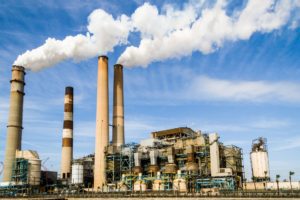
HARRISBURG, PA (November 22, 2023) On November 21, Governor Shapiro announced his decision to appeal the November 1 Commonwealth Court decision that declared the Regional Greenhouse Gas Initiative (RGGI) to be unconstitutional.
RGGI is a program established in 2005 that requires regulated power plants to acquire allowances for the carbon emissions they produce. Within the currently-participating states, RGGI reduces emissions from fossil fuel power plants and funds climate change initiatives with the collected fees. Proceeds from the program in Pennsylvania would go to the state’s Clean Air Fund, which can then be put towards efforts that reduce air pollution. By not implementing RGGI, Pennsylvania has already missed out on over $1 billion dollars in RGGI proceeds since January 2022 that would have gone towards air pollution reduction programs.
Executive Director and Chief Counsel, Joseph Otis Minott, Esq. issued the following statement:
“As the nation’s fourth largest emitter of carbon dioxide, Pennsylvania needs RGGI, an effective cap-and-invest program, to advance a commonsense energy plan that cuts climate pollution and ensures an equitable energy transition and the jobs that come with it. The Governor’s appeal gives us a crucial chance to participate in this program and secure a clean energy economy for Pennsylvania. The Governor’s diverse RGGI stakeholder group reached the consensus that such a cap and trade program for the power sector would be critical for generating the funds needed to support the state’s clean energy transition. RGGI is the clear choice for meeting the working group’s goals and Governor Shapiro’s criteria of supporting climate action, clean energy job creation, public health protection, and energy affordability.”

Sean Deresh is an undergraduate student in the Vagelos Integrated Program in Energy Research studying Earth Science in the College of Arts and Sciences and Chemical and Biomolecular Engineering in the School of Engineering and Applied Science at the University of Pennsylvania. He is a volunteer advocate with the Clean Air Council, a member of Penn Sustainability’s Student Advisory Group for the Environment, and a research assistant at Penn’s Kleinman Center for Energy Policy.
Sean is interested in the future direction of the global oil market and what factors might help reduce our reliance on oil as a primary energy source.
Recent fluctuations of the oil industry: a call for energy policies that embrace renewable development
Given the magnitude of the impending effects of climate change, many sectors have begun to explore alternative avenues for energy consumption that either reduce or eliminate greenhouse gas emissions. Crude oil, one of the primary fossil fuels, has proven to become a driving force in the US energy industry due to its high energy density and low cost. The current US energy policy landscape is still in a transitional phase, and as the Biden administration continues to set goals for expanding renewable energy supply in the US, it is only a matter of time before oil dependency is minimized. The volatility of the global oil market due to drastic fluctuations in supply and demand and recent geopolitical tensions are clear indicators that energy policy must be restructured to help foster a landscape that is not so dependent on oil and can withstand potential changes in energy resource supply. Oil prices are currently hovering around $100 per barrel due to a combination of upward pricing pressure on concerns of reduced Russian oil supply and fears of a renewed COVID-19 economic attenuation in China24. A decline in US oil inventories is putting even more pressure on the price of oil as the nation’s strategic reserve is depleted and the Russia-Ukraine war continues. Through time, mass electrification will inevitably emerge as one of the primary solutions to high gas prices, as global oil trends favor enhanced clean development.
The current dilemma
The balance of international power is a key factor in the oil industry, with the future fortunes of countries such as Russia and Iran tied to crude oil. Geopolitical tensions and the disparity between supply and demand have led to an increase in the price of crude oil. Prices increased by more than 15% in January, as the global benchmark price crossed $90/b for the first time in over seven years, as fears of Russian invasions in Ukraine grew14. Upon the Russian invasion of Ukraine, the price of crude oil rose to nearly $96/bbl and Brent crude — the global benchmark for oil prices — went as high as $105.79 for the front-month contract20. The tension between Russia and the West is growing and President Putin is willing to take geopolitical risks to assert his power. If Russian production is interrupted, the US, Japan, European countries, and China could release mode crude oil from their reserves in the event of a crisis. This invasion has caused many entities such as the EIA and investment banking firms to increase their oil price predictions.
Energy experts and E.U. Officials have expressed that Russia’s invasion of Ukraine is poised to add more urgency to Europe’s efforts to reduce its dependence on Russian oil and gas and to compel Europe to speed up its transition to renewable energy. Discussions of accelerating the transition toward alternative sources of energy began months ago as oil and gas prices began to rise and recently intensified as tensions grew closer to war with Russia. The recent invasion of Ukraine then increased the risk of Europe’s reliance on Russian gas. For instance, Germany, which has been ramping up its wind and solar capacity and shuttered coal-fired and nuclear facilities, has viewed natural gas as a reliable fuel that can get the country through the transition. However, Germany currently receives about half of its gas supply through pipelines from Russia and does not have the infrastructure to take shipments of liquefied natural gas (LNG) from other sources. As Russia’s gas flows have slowed, Germany’s feeling of reliability has shifted.
The energy transition will be easier for some countries in Europe than others. Some countries could actually return to polluting fuels such as coal-reliant Poland, as renewables still have a long way to go there and it might not seem feasible to meet demand amidst such heightened geopolitical tensions and risks. If the alternative is to stay on course with decarbonization at the expense of high energy prices or vulnerability, this will be hard to achieve, and compromises that will soften climate ambitions set out by the E.U. will have to be established. A European gap without gas could mean relying more on coal and sources such as nuclear by bringing them back online or reducing demand among households and the industry. An E.U. plan to tax carbon-intensive imported goods could have costly impacts on countries such as China and Russia, which have weaker environmental regulations. Absolutely everything could change if the invasion expands beyond Ukraine, and depending on how long this conflict lasts, it could affect U.N. climate talks when countries revise goals for reducing emissions. Geopolitical tensions could drive Russia toward China or even into isolation. If sanctions affect Russia’s access to the markets in the West, they will have to seek other economic opportunities. Losing Europe as a major customer would leave Russia with few options to sell its gas in the short term.
The crude oil landscape
In recent years, American consumers have been facing a sustained increase in prices for oil products1. As a global commodity and primary source of fuel for the global economy, crude oil has a price that is determined by both supply and demand, reflects buyer-seller interactions1, and has recently experienced an unprecedented shift amidst the COVID-19 pandemic. The primary activities required to move crude oil from source to consumer include production, refining, distribution, and marketing1, and such activities take place in the global marketplace. The world currently consumes over 97 million barrels of oil per day2, and its proven reserves are equivalent to 46.6 times its annual consumption levels, suggesting that planet Earth has 47 years of oil left under current consumption rates2. This would be the equivalent of going above and beyond the “business as usual” emissions scenario of global circulation models, resulting in the strongest possible set of climate change effects18.
The global oil market is complex. Various countries currently produce oil, but only a few of them dominate production3. Nearly 100 countries produce crude oil around the globe, but in 2020, only five of them accounted for 50% of the world’s total crude oil production: United States with 15%, Russia with 13%, Saudi Arabia with 12%, Iraq with 6%, and Canada with 5%4. There are three types of companies that supply crude oil in the global market4. International oil companies (IOCs) such as ExxonMobil, BP, and Royal Dutch are investor-owned. National oil companies (NOCs) are extensions of government or government agencies and include companies such as Saudi Aramco (Saudi Arabia), Pemex (Mexico), the China National Petroleum Corporation (CNPC), etc. The Organization of Petroleum Exporting Countries (OPEC), an international cartel of oil-producing countries, is the most powerful production-level entity. In 2020, OPEC’s members held 71% of the world’s total proven crude oil reserves and accounted for 36% of total world crude oil production4.
Crude oil is bought and sold throughout a chain of distribution and its price is a function of supply and demand conditions, which are more important in determining the price of oil than trade flows in the long term. Recent changes in supply and demand have increased the prices paid by retailers and consumers for crude oil.
Looking ahead
The burning of gasoline and diesel are primary forces for global warming. As the years progress, the world will indubitably continue to perpetuate the transition toward clean energy sources and reduce its reliance on oil. Fortunes could be made or lost from shifts in the energy economy, which is controlled by some of the largest private and state corporations in the world. Oil companies will be at the forefront of change and undercut their own businesses. Regardless, there are still clear indications that the global demand for oil will peak and decline by the late 2030s11.
Electric vehicles certainly have the potential to drive the crude oil market towards a new trend against its perpetuation as an energy source. Federal transportation and energy officials recently detailed where the first millions of the government’s $7.5 billion funding for electric vehicle charging infrastructure will go, laying the foundation of a system that could establish where Americans fuel for decades to come19.
Western oil companies, under pressure from investors and environmental activism, are drilling less oil wells than before the pandemic restrained supply increases. Biden has been urging OPEC to pump more oil, and OPEC’s members and their allies have recently agreed to plan to increase production14. The Biden administration also announced that it would release 50 million barrels of oil from its strategic reserves to relieve pressure put on consumers. These recent calls for OPEC to increase production amidst increased demand is not consistent with his ideals of carbon neutrality and emissions reductions. The Biden administration continues to refuse to confront the oil industry even though it continues to develop at an outstanding pace. As the uncertainty of the future oil market grows given recent events, the Biden administration must consider environmental justice in its development of new initiatives to reduce the intensity of the instability of the oil industry.
Recent changes in supply and demand have increased the prices paid by retailers and consumers for crude oil. By the end of 2022, the price of crude oil will have increased due to the recovery from strained supply caused by the COVID-19 pandemic, the initiation of increased production from OPEC members, and tensions between foreign nations. Near 2030, oil demand will begin to peak as consumption growth diminishes and global inventories are greatly replenished, causing the price of crude oil to decrease. It might sound like a long time, but in the grand scheme of things it would be beneficial for the Biden administration to develop regulatory reforms that limit or inhibit oil extraction and development so as to initiate a decay in the Nation’s dependence on the source.
Energy policy outlook23
- We must develop novel energy policies that embrace renewable energy for electricity generation to achieve significant carbon pollution reductions by midcentury.
The US needs to do more to avert the impacts of climate change. Meeting climate goals will require the implementation of new policies that control emissions of carbon and other greenhouse gases. The US cannot simply rely on fossil fuels in the way it has in the past. By adopting sustainable policies, the US has the potential to generate a large portion of its electricity from zero-carbon emitting sources by the target dates. Strong domestic cooperation will be needed to facilitate international action. The US electricity sector is responsible for a large percentage of the nation’s carbon dioxide emissions. Long-term dependence on fossil fuels for power generation is incompatible with the response needed to mitigate the impacts of climate change. Renewable energy is booming but still lags behind traditional fuels. Policymakers must promote the rapid decarbonization of the power sector and the deployment of renewable energy technology.
- We must invest in safe, resilient, and reliable energy infrastructure.
Decisions that policymakers make today will last for decades to come. The modern electricity grid must accommodate expanded and diverse generation from renewable energy sources and provide reliable service. In the future, reliability will go hand in hand with ensuring that our energy infrastructure is resilient to the impacts of climate change, such as extreme weather. All energy infrastructure (pipelines, railroads, production facilities, etc.) should adhere to the highest standards of public safety so as to ensure proper climate action.
- We must reduce the transportation sector’s dependence on oil.
In order to meet the nation’s emission reduction goals, the US needs to continue to make cars and trucks cleaner and more efficient. The US should envision moving away from a transportation sector that is highly dependent on oil to one that relies on alternative energy sources, electricity being one of them. Manufacturers have already developed low-emission or zero-emission vehicles, and new technologies are appearing every year. Policymakers should provide consumers and governments with incentives to continue the transition to a cleaner transportation system.
- We must empower the energy consumer by ensuring equitable access to clean energy.
Energy policy is about more than supply and demand and market interactions. As technology and innovation change to the energy industry, consumers will have new opportunities to benefit from clean technologies to lower their energy costs. Consumers should be free to make sustainable energy decisions, such as installing solar panels or purchasing an electric car, without paying ridiculous fees that are designed to inhibit development. A clean energy economy must also be inclusive in that consumers from all income levels should have the opportunity to experience the benefits of clean energy technology.
- We must balance the impacts of energy production with the protections of citizens’ public lands and fair returns to taxpayers.
Oil and gas drilling, coal mining, and even renewable energy production in some cases, all have environmental costs associated with them. Policymakers should minimize these impacts by deciding which locations are appropriate for development and which are simply not feasible. Energy development should be balanced with protections for landscapes, the reinvestment of energy revenues in the conservation of land, water, and wildlife, and the enforcement of mitigation and reclamation requirements. Public lands and waters belong to all citizens, so taxpayers should be compensated for the extraction and development of their energy resources.
Email: sderesh@sas.upenn.edu
References
- Grant, Kenneth, et al. “Understanding Today’s Crude Oil and Product Markets.” Lexecon, an FTI Company, 2006, https://www.heartland.org/_template-assets/documents/publications/19500.pdf.
- “Oil Consumption by Country 2022.” World Population Review, https://worldpopulationreview.com/country-rankings/oil-consumption-by-country.
- “Frequently Asked Questions (FAQS).” U.S. Energy Information Administration (EIA), 8 Dec. 2021, https://www.eia.gov/tools/faqs/faq.php?id=709&%3Bt=6.
- “Oil and Petroleum Products Explained, Where Our Oil Comes From.” U.S. Energy Information Administration (EIA), 8 Apr. 2021, https://www.eia.gov/energyexplained/oil-and-petroleum-products/where-our-oil-comes-from.php.
- “Energy & Financial Markets: What Drives Crude Oil Prices?” U.S. Energy Information Administration (EIA), https://www.eia.gov/finance/markets/crudeoil/.
- “Short-Term Energy Outlook.” U.S. Energy Information Administration (EIA), 11 Jan. 2022, https://www.eia.gov/outlooks/steo/.
- “EIA Forecasts Crude Oil Prices Will Decline during 2022.” U.S. Energy Information Administration (EIA), 18 Nov. 2021, https://www.eia.gov/todayinenergy/detail.php?id=50396#:~:text=We%20expect%20that%20the%20price,%2462%2Fb%20in%20December%202022.
- “EIA Forecasts Crude Oil Prices Will Fall in 2022 and 2023.” U.S. Energy Information Administration (EIA), 12 Jan. 2022, https://www.eia.gov/todayinenergy/detail.php?id=50858#:~:text=In%20our%20January%202022%20Short,%2479%20per%20barrel%20(b).
- Shalett, Lisa. “Rising Oil Prices Pose Risks.” Morgan Stanley, 29 Apr. 2019, https://www.morganstanley.com/ideas/rising-oil-prices-pose-risks.
- Egan, Matt. “Oil Prices Will Surge to $100 This Year, Goldman Sachs Warns.” CNN, Cable News Network, 18 Jan. 2022, https://www.cnn.com/2022/01/18/energy/oil-prices/index.html.
- Krauss, Clifford. “Foretelling the Future of Oil.” The New York Times, The New York Times, 9 Oct. 2018, https://www.nytimes.com/2018/10/09/business/foretelling-the-future-of-oil.html.
- Rapier, Robert. “Saudi Arabia Proves That Oil Is Power.” Forbes, Forbes Magazine, 24 Oct. 2018, https://www.forbes.com/sites/rrapier/2018/10/24/saudi-arabia-proves-that-oil-is-power/?sh=6645fdf342e8.
- Neuhauser, Alan. “Why Oil Forecasts Keep Getting It Wrong | National News …” U.S. News, 25 Sept. 2018, https://www.usnews.com/news/national-news/articles/2018-09-25/why-oil-forecasts-keep-getting-it-wrong
- Krauss, Clifford. “Why Are Oil Prices So High and Will They Stay That Way?” The New York Times, 2 Feb. 2022, https://www.nytimes.com/2022/02/02/business/economy/oil-price.html.
- Urbi, Jaden. “Here’s What Drives the Price of Oil.” CNBC, 17 May 2018, https://www.cnbc.com/2018/05/15/what-drives-oil-prices.html.
- “Factors Influencing Crude Oil Price.” Factors Influencing Crude Oil Price | EBF 301: Global Finance for the Earth, Energy, and Materials Industries, Penn State College of Earth and Mineral Sciences, https://www.e-education.psu.edu/ebf301/node/752.
- “Oil Price Charts.” OilPrice.com, https://oilprice.com/oil-price-charts/#WTI-Crude.
- “20 Questions and Answers”. Climate Change Evidence and Causes, https://www.nap.edu/resource/25733/interactive/.
- “Biden Admin Details First Contours of EV Charging Network.” Subscriber.politicopro.com, https://subscriber.politicopro.com/article/eenews/2022/02/10/biden-admin-details-first-contours-of-ev-charging-network-00007610.
- Domonoske, Camila. “Oil Surges Past $100 a Barrel after Russia Invades Ukraine.” NPR, NPR, 24 Feb. 2022, https://www.npr.org/2022/02/24/1082571179/oil-surges-past-100-a-barrel-after-russia-invades-ukraine.
- U.S. Energy Information Administration – EIA – independent statistics and analysis. (2022, February 8). Retrieved March 4, 2022, from https://www.eia.gov/outlooks/steo/.
- Allen, N. (2022, March 18). Morgan Stanley Ups Oil Price Forecast, again. SeekingAlpha. https://seekingalpha.com/news/3814548-morgan-stanley-raises-oil-price-forecast-again.
- “Key Principles for an Energy Policy that Meets U.S. Environmental and Economic Needs” The Center for American Progress, 26 Oct. 2015.
- Rittmeyer, Brian. “Oil Market Volatility Brings End to Declining Gas Prices, Analysts Say”. TRIB Live. 25 April, 2022. https://triblive.com/local/regional/oil-market-volatility-brings-end-to-declining-gas-prices-analysts-say/.
Image sources:
https://www.maxpixel.net/Solar-Panel-Renewable-Energy-Sun-Renewable-Energy-3191780
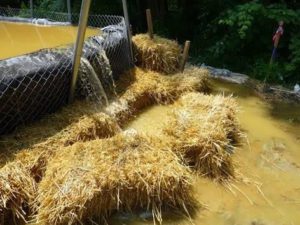
After a slew of legal filings, briefs, and hearings before two different courts, the Environmental Hearing Board, on Monday, April 16th, ordered stronger protocols for responding to and preventing drilling fluid spills on the Mariner East pipelines. Clean Air Council, Delaware Riverkeeper Network, and Mountain Watershed Association took Sunoco and the Pennsylvania Department of Environmental Protection (DEP) to court for violating a previously agreed-upon version of the protocols, and then quietly modifying those protocols without the input of the Council, other organizations, or the court.
The history of these protocols, called the Horizontal Drilling Inadvertent Return Assessment, Preparedness, Prevention and Contingency Plan (or HDD Plan for short) is somewhat complicated. The HDD Plan was originally part of the water permits DEP issued to Sunoco for the Mariner East 2 pipelines in February 2017. In August 2017, after a torrent of drilling fluid spills and drinking water contamination incidents made clear that the February 2017 HDD Plan was failing to protect the public and the environment, Clean Air Council and its partners filed an emergency motion with the court. This resulted in the court shutting down Sunoco’s drilling Mariner East 2 drilling operations until the parties agreed to improvements to the HDD Plan in August 2017. Fast forward six months, and DEP and Sunoco walked back some of those protections in a side agreement. Clean Air Council and its partners filed another emergency filing and have ultimately secured the most protective HDD Plan yet. And this time the stakes are higher if there are further violations.
The new HDD Plan accomplishes several important things. First, it now applies to all drilling methods that could result in drilling fluid spills. Second, professional geologists must be involved in determining whether it is safe to proceed with drilling after a spill. The new HDD Plan lays out specific requirements for what the professional geologist must investigate and present to the DEP. DEP then must find that any plans for continued drilling at the spill site adequately protect the public and the environment before it allows drilling to restart. Groundwater protections have been spelled out in detail so there can be no ambiguity in how they are applied; they are key because of the damage Sunoco’s operations has already caused to drinking water supplies and the continuing nature of that threat. Requirements for notifying DEP and the public about drilling incidents have also been improved.
There will also be increased transparency so landowners and other concerned members of the public will be better able to track any future spills that may arise: Reports prepared by Sunoco’s geologists will be shared with Clean Air Council and its partners. DEP’s documentation of spills on its website will be expanded, made uniform, and include more detail about spill locations–a key piece of information that had previously been missing.
The new HDD Plan is comprehensive, strongly protective, and scientifically rigorous. Perhaps just as important, the Environmental Hearing Board has made it crystal clear that it will not tolerate Sunoco and DEP trying to change it behind the backs of the public again. Even with these improvements, Clean Air Council is under no illusion that the new HDD Plan will be a silver bullet against all future problems and we believe it is still important to keep a watchful eye on construction operations.
You can view the new, April 2018 version of the HDD Plan here
Photo by Faith Zerbe/Delaware Riverkeeper Network
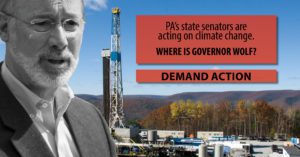
Today, Clean Air Council on behalf of 7000 contributors and 35,000 activists across Pennsylvania launched a new campaign imploring Gov. Wolf to step up and start to lead by taking action on climate. The effort kicks off with digital ads on multiple news sites and an online grassroots petition.
Dangerous weather is brewing. The major uptick in extreme weather events is a clear sign that the climate is changing at a rapid pace. Recently, Americans experienced the bitter cold of the “bomb cyclone” in the East, a massive winter wildfire outside of Los Angeles, and unusually low western snowpack. Just last week, the National Oceanic and Atmospheric Administration reported that 2017 was the third hottest year on record (only slightly behind 2015 and 2016).
Now, the Trump Administration is aggressively rolling back vital protections to cut methane emissions from the oil and gas sector and carbon emissions from the power sector – while beginning the process to undermine required emission reductions in the transportation sector as well.
The case for strong state action has never been clearer.
Without strong action from Gov. Tom Wolf, the massive amounts of climate-changing pollution, both methane and carbon dioxide, spewing from Pennsylvania’s vast energy infrastructure could go unchecked. Governors, mayors, and major corporations across the country are voicing their commitment to meet ambitious climate goals— yet the state of Pennsylvania, the 3rd largest greenhouse gas polluter in the nation with tens of thousands of active oil and gas wells and dozens of coal-fired power plants, is missing in action.
Thankfully, our local elected officials are stepping up to protect Pennsylvania communities. The mayors of Allentown, Ambler, Bethlehem, Downington, Lancaster, Philadelphia, Pittsburgh, State College and Swarthmore have all pledged to work to secure the pollution reductions committed to under the Paris Climate Agreement.
And just today, Pennsylvania Sens. Jay Costa and Wayne Fontana from Pittsburgh stepped up with a bold vision for action, introducing legislation directing the state to take concrete actions to secure meaningful reductions in carbon pollution and to achieve ambitious economy-wide climate goals.
Unfortunately, Gov. Tom Wolf has failed to lead on climate change. It is time to change that.
During his initial 2014 run for office, Gov. Wolf acknowledged that tackling methane emissions from oil and gas operations was critical to our environment. And just one year into his administration, he pledged to cut methane emissions from new and existing drilling operations across the state.
Fast forward to today, and we are still waiting for Gov. Wolf to introduce a proposal that would limit emissions from tens of thousands of oil and gas wells that operate today that put the health of our communities at risk. Not only is methane a powerful climate change pollutant, but these drilling operations release smog-forming pollutants that pollute the air we breathe. Cutting methane would address climate change and protect our health by helping to reduce the rate of asthma and other respiratory diseases.
Gov. Wolf also vowed to limit carbon pollution from Pennsylvania’s power sector, clearly indicating on the campaign trail that he supported working with other states to clean up our air and secure our climate. Despite this promise, and in stark contrast to bold action taken in nearby Virginia to reduce carbon pollution from the state’s power plants, Gov. Wolf has again failed to lead.
With federal policies now in shambles, inaction is no longer an option for Pennsylvanians. By not acting, Governor Wolf is putting the health and welfare of Pennsylvania communities in the hands of Washington climate change denying bureaucrats and industry lobbyists – that is unacceptable.
That is why the Clean Air Council has launched a campaign calling on Gov. Wolf to lead and act on climate change.
Governor Wolf can and should fulfill two long overdue promises made to Pennsylvania voters during his last campaign by moving forward to:
- cut methane pollution from existing oil and gas operations; and
- set a hard limit on carbon pollution from Pennsylvania’s power sector.
He had it right back in 2014—put Pennsylvania in the driver’s seat by moving ahead with ambitious policies to tackle two significant sources of climate pollution in the Commonwealth. Inaction is no longer an option.
Pennsylvanians deserve better—real leadership on a deeply urgent problem.
Want to help? Sign our petition telling Gov. Wolf to act now on climate change.

Clean Air Council and partners Moms Clean Air Force, Clean Water Action, and Earthworks joined residents affected by natural gas operations and a Harrisburg-area physician to speak at a press conference and Pennsylvania Department of Environmental Protection (DEP) air quality committee meeting.
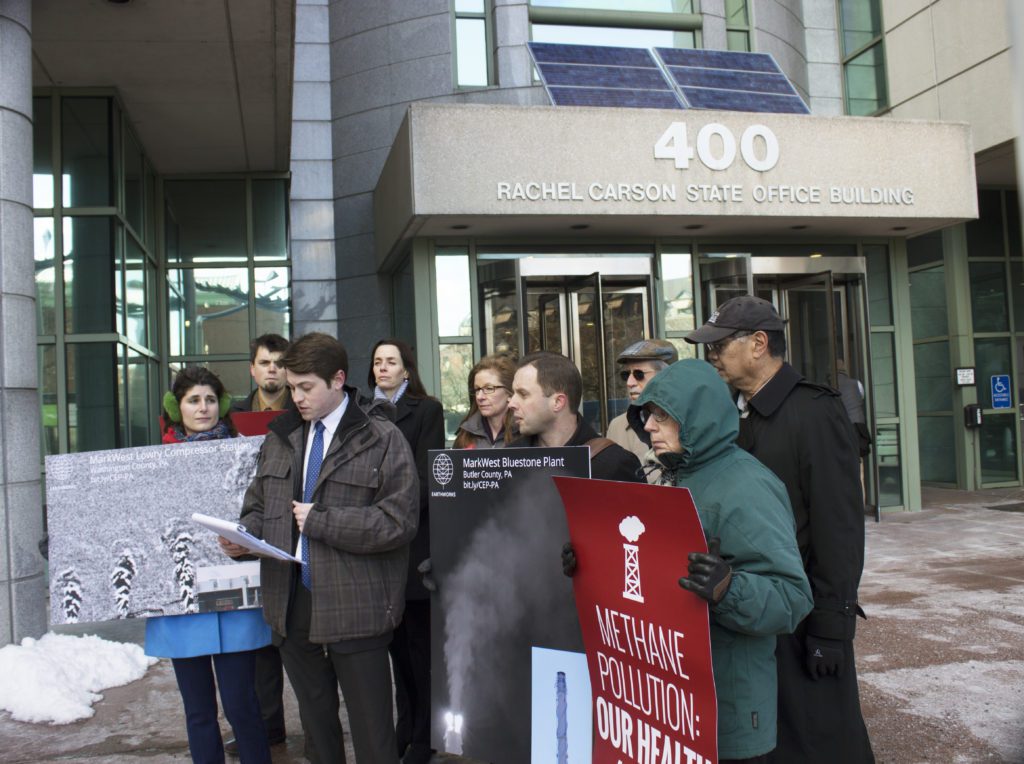
Clean Air Council Attorney Robert Routh reads his public comments during the press conference
Members from Clean Air Council and their partners spoke on the steps of the Rachel Carson State Office Building, just a few blocks from Governor Wolf’s office. You can watch excerpts from the press conference below.
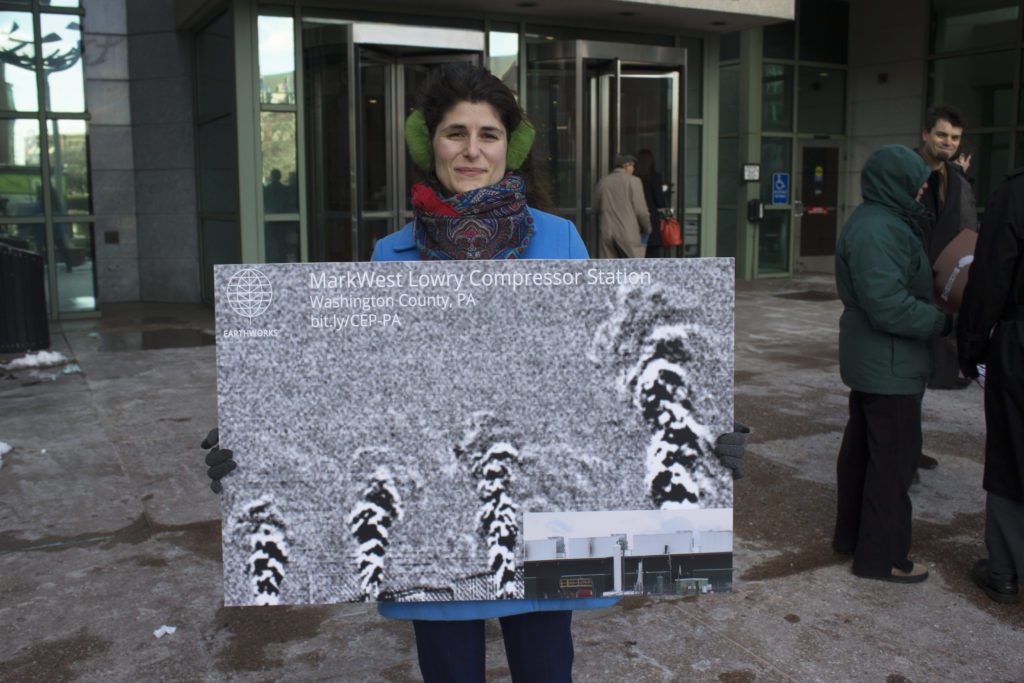
The comments were a continuation of advocacy that has spanned three years urging Governor Wolf to fulfill his campaign promises on methane controls for the natural gas industry. At the meeting, the DEP presented the final draft of permits to control methane pollution from new and modified natural gas operations.
The Department also presented concepts to control volatile organic compounds from existing natural gas operations, which are the bare minimum they are required to do under federal guidelines. You can read the full press release here.

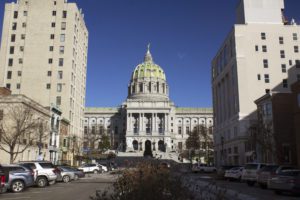
FOR IMMEDIATE RELEASE:
December 14, 2017
Contact:
Justin Wasser, Clean Air Council: 814-242-3156
Impacted Residents, Health Experts and Environmental Advocates Urge Gov. Wolf to Advance Methane Pollution Standards for the Natural Gas Sector
Harrisburg, PA (December 14, 2017)- The Pennsylvania Department of Environmental Protection (DEP) presented today the final draft of permits to control methane pollution from new and modified natural gas operations to the Air Quality Technical Advisory Committee (AQTAC). Residents affected by natural gas operations, as well as environmental and public health advocacy groups from across the Commonwealth, spoke at a press conference and at the AQTAC meeting during the public comment period. The comments were a continuation of advocacy that has spanned three years urging Governor Wolf to fulfill his campaign promises on methane controls. Wolf first promised to cut methane pollution from all new and existing gas operations on the campaign trail in 2014. He announced his methane reduction strategy in January 2016.
Environmental and public health advocacy groups and impacted residents were pleased to finally see progress made on the methane reduction plan at the meeting, but say that the Wolf administration must quickly finalize general permits and require companies to comply with them. Groups raised concerns about the administration’s proposed concepts for weaker rules covering existing source of methane pollution — a major departure from what the governor promised to do.
“While the progress being made on methane standards covering new natural gas sources is encouraging, the Wolf administration must move quickly to regulate existing sources in a similar way,” said Joseph Otis Minott, Executive Director and Chief Counsel of Clean Air Council. “What DEP is proposing to implement on existing sources is the bare minimum required by law. Governor Wolf must go well beyond the bare minimum in protecting the health of Pennsylvania citizens. We elected this governor based on his promises to be a leader in addressing methane pollution and climate change. Pennsylvanians deserve that leadership.”
Methane, a very potent greenhouse gas, is accompanied by air pollutants harmful to human health when it leaks from natural gas operations. Emissions in Pennsylvania continue to rise year after year.
The standards for new and modified sources will be implemented through two general permits, which allow for a streamlined approval process if industry operators agree to adhere to the permit conditions. One permit, GP-5A, covers unconventional gas wells and pigging operations and the other, GP-5, covers processing plants and compressor stations, including those on large transmission pipelines.
“Comprehensive methane rules for existing sources of pollution must be broader in scope and more stringent than the requirements found in EPA guidelines,” said Robert Routh, staff attorney for Clean Air Council. “These guidelines represent the national floor. Governor Wolf and DEP need to lead here and aim much higher for the sake of all Pennsylvanians.”
“The citizens of the commonwealth are suffering needlessly when we have the tools and technology available to greatly limit methane pollution and help clean our air,” said Dr. Robert Little, a family physician and president of the Harrisburg/Hershey chapter of Physicians for Social Responsibility. “It bears emphasizing that we need to clear our air of both toxic hydrocarbons and emissions of methane – reducing one kind of pollution without the other gets us nowhere.”
“Until these new source rules are applied to existing sources, people in my community and others dealing with methane pollution right now are still looking at an unfulfilled promise by Governor Wolf,” said Lois Bower-Bjornson, an impacted resident of Washington County, PA. “I am urging Governor Wolf to be that leader who campaigned on a promise of holding the natural gas industry accountable to the people of Pennsylvania and move forward on rules for existing sources of methane pollution and VOCs immediately.”
“Today, my children and 3,200 of their classmates are attending school next to a gas well pad roughly half a mile away exposing them to a known health and safety risk from oil and gas air pollution including emissions of methane and volatile organic compounds,” said Patrice Tomcik, a mother of two sons from Butler County and a Field Consultant with Moms Clean Air Force, a 1 million member strong organization. “Let’s be clear: This problem will not be resolved unless and until DEP addresses these toxic pollutants like benzene, as well as methane emissions.”

The Energy Co-op is honored to partner with the Clean Air Council to participate in this year’s GreenFest Philly. Both organizations have a long history of advocating for a cleaner future and the Co-op to excited to celebrate the common values that unite and grow our community. As the Clean Air Council celebrates its 50th anniversary, The Co-op is proud to be a supporter to allow the Clean Air Council to continue its mission for another 50 years.
Based in Philadelphia, The Energy Co-op is the region’s only non-profit, member-owned energy supplier. Established in 1979, The Co-op found a better way to buy energy. The Co-op offers clean electricity, green natural gas, bio heat and standard heating oil. By being a cooperative member and simply paying your energy bill, you can be sure that you are making a lasting impact. Don’t just choose your energy company; own it. You can join the Philadelphia Energy Co-op through their web site at www.theenergy.coop or by calling them at 215-413-2122.


